

Teacher's Workstation
A collection of teaching resources by elementary ali.

Week 5 Science Lessons: Solutions (5th Grade)

I am so excited to get these lesson plans rolling! Each week of your school year can now be stress free because I am going to be sharing my lesson plans with you for free every week!! This will be for elementary science grades 2nd, 3rd, 4th, and 5th since those are the grades I have curriculum for. I don’t want you to miss out on a single free lesson plan, so make sure you sign up right now to get these sent straight to your inbox!!
This week we will continue on with the Matter and Energy physical science concept standards for 5th grade Science! The physical science standards are what schools typically cover first, but you can check out my elementary science scope and sequence to see which weeks line up with your school’s scope. Here is your stress-free lesson plan for the week.
Standards Covered:
5.5 (C) identify changes that can occur in the physical properties of the ingredients of solutions such as dissolving salt in water or adding lemon juice to water.
5-PS1-2 Measure and graph quantities to provide evidence that regardless of the type of change that occurs when heating, cooling, or mixing substances, the total weight of matter is conserved.
5-PS1-4 Conduct an investigation to determine whether the mixing of two or more substances results in new substances.
Guiding Question:
How do the properties of the ingredients in a solution change when they are mixed together?
The Lesson:
And now, for all the fun and engaging learning! Click the image to grab your printa ble lesson plans for the week. Click any image in the post to grab the whole lesson set that’s ready to print and teach.

To make my life easier, I plan each each with the same structure. Students like the routine and it helps them know what to expect for each day of the week.
Each day of the week, students will walk in and get to work on their Daily Science Starters. This is a favorite activity of mine that I started using in a middle school science classroom. I saw how well it got students in science class mode AND deterred misbehaviors while students were waiting to get started. Each day has its own question that leads into the learning for that day. I like to go over the question and let students share their answers with the class. You may catch some misconceptions with these, but the questions are just to get students thinking.

Before moving into the lesson, complete column one of the Word Wall Builder Chart . Have students think about what each key term means before they learn about it. This is a way to get vocabulary on their mind and to help students identify their own misconceptions as they learn more through the week. Word Wall Builder Charts are my favorite way to make your word wall more interactive and useful. I always provide printable versions for students to record their own answers, plus a class version to post in the room through the week. You can see below that I use sticky notes to make my chart paper reusable each week.

To start off the lesson week, I like to give students an activity that grabs interest and activates or establishes some schema (background knowledge). This can be a great starting point for noticing some misconceptions, too. For this week, we are making it fun with Color Solutions. Students will work in a group mixing their favorite colors together. The twist comes when they try to pull their color back out!
Now that you have solutions on students’ minds, you can introduce the base knowledge for the concept. The informational text is not a tell-all text. It is designed to give students terminology and conceptual base knowledge of the concept, so that the real learning and discovery can come through hands-on learning and labs. There are three key terms in bold that students will define using context clues. This will work with the Word Wall Builder Chart to build student knowledge of each key term.
Differentiate this text as needed for your students. Some things I like to do is continue a gradual release of this activity with students who need the assistance.
Follow up the reading with a graphic organizer to process and use the information they read so they can better retain that information. I create a themed graphic organizer for each text that doubles as visual notetaking or note doodles or coloring notes. They use what they read or learned to complete the graphic organizer. This one shows them how the molecules look/act in a beaker for each state.
End this day with the Content Area Focus Wall Exit Slips and/or introduce the project (if you plan to do the weekly projects). Weekly project make a great extension for this lesson. Your campus STEM teachers could use them to help you cover each topic, or you can use them for enrichment opportunities for your high achievers or GT.

After Science Starters, complete the context clues part of the Word Wall Builder Chart. This will refresh student memories so they can work on their Summary Writing with Key Terms. These key terms from their reading give students a guide for writing a summary about what they have read. This is a second way they interact with the reading and process the information. Work with your ELA standards to encourage best practices for summary writing.
And now for one of my favorite teaching tools: the anchor chart . Anchor charts will be a great reference for the rest of the year. Free classroom decor!! Anchor charts can be created on chart paper using the printable version as a guide. You can also make your anchor chart using a dry erase poster to save on chart paper. Students will have their own copy to reference in their notebook. Have students follow along by creating their own or filling out a printable version in their interactive notebook. Anchor charts are the perfect teacher input for interactive science notebooks . I provide moveable pieces for each anchor chart that can be added to make these more fun and interactive for their notebooks. Today’s anchor chart will define each state of matter .
End this day with the Content Area Focus Wall Exit Slips and/or work on the project (if you plan to do the weekly projects).

My favorite day of the week!! Lab day ! This week is a simple science investigation for students to explore solutions. Students will observe, then mix together the salt and water. They will separate the solution and observe the substances again to see how mixing the substances together changed the substances.
Add in some vocabulary practice with the matching cards, if you have time leftover after the lab. The vocabulary practice pages make good homework practice!

By this point in the week, we have given students all of the teacher input activities so we can move on to the student output activities. Students will now process and apply the information they have learned.
After Science Starters, complete column 3 and 4 of the word wall chart by filling in the actual definition of the words and illustrate the word.
It is time to complete the Output activity for the Interactive Science Notebook. For this topic, they will create their own mixture and have a partner decide how to separate it. This is across from their anchor chart, so they can reference it before asking for help.
Analyzing Data is one STAAR-like question that students work through to apply what they have learned. This also builds their test taking skills throughout the year. Going over these in depth can help you teach students how to work through questions like this. I love how having these each week really set students up for success when testing day comes. You can see an image of the Analyzing Data page plus a look at the project pages.

You made it! The weekend is near!! Friday is a simple day. After going over the last Science Starter of the week, the main activity is the formative assessment. A Claim It and Explain It writing is such a good way to assess what students learned. This is an open ended write with a specific purpose. I always give a question that student answer with a claim. Then, they explain their thinking with evidence and reasoning. This is a good time to work in the three vocabulary pages, if you haven’t used them as homework assignments. If you have time left over, you can play a couple of my favorite review games that prep students for the end of the year. Science Says and Diagram Draws are a fun way to make science words and science diagrams stick throughout the year. I love to play Science Says anytime we have extra time in class or my students just need a brain break.
I hope this gives you some good ideas for a whole week of learning. My goal is to provide you with engaging lessons that are ready to go each week so you can spend far less time planning and prepping, and far more time spoiling yourself **because you deserve it!** Enjoy your weekend!!
RECOMMENDED RESOURCES FOR TEACHING SCIENCE
To make your teacher life even easier, I have put my lesson activities and materials into easy to use files. This saves all the time we spend scrolling and collecting lesson resources. Just print and add simple lab supplies! Or, go digital for NO PREP! No making copies, and the lab is virtual – Talk about saving your sanity.

Solutions Complete Lesson Set
Everything you need for a week (or two) of learning. Printables, lesson plans, teacher instructions. Just add simple lab supplies for a low prep week.
Highly Rated by Districts and Teachers (5 Star Rating)

Solutions DIGITAL Complete Lesson Set
Everything you need for a week of learning. One file with a student activity guide and all activities including a Digital Lab means NO PREP !!
Highly Rated by Districts and Teachers (4.5 Star Rating)

EVERYTHING 5th Grade MEGA Bundle
Everything you need to teach a whole year of Science. Just add simple lab supplies. Each week of learning is provided, including the digital version. All extra activities and resources that apply to 5th grade science are included in this bundle, too! My original year of lesson sets is included PLUS my New & Improved year of lesson sets. This is great for added tutoring materials, additional learning activities, or differentiating instruction.
- Highly Rated by Districts and Teachers
- (5 Star Rating)
Here is the lesson plan link again. And, don’t forget to join the Science Newsletter so you never miss a planned week of learning!
Share this:
Leave a reply cancel reply, discover more from teacher's workstation.
Subscribe now to keep reading and get access to the full archive.
Type your email…
Continue reading
- The Open University
- Accessibility hub
- Guest user / Sign out
- Study with The Open University
My OpenLearn Profile
Personalise your OpenLearn profile, save your favourite content and get recognition for your learning
About this free course
Become an ou student, download this course, share this free course.

Start this free course now. Just create an account and sign in. Enrol and complete the course for a free statement of participation or digital badge if available.
1.2 Linking the introduction to the assignment question
A good introduction aims to show the reader that the essay will provide a relevant answer to the assignment question. To achieve this, the introduction should link back to the question. This is done by writing a paragraph that deals with all the key content mentioned in the assignment question. This is reinforced by the use of words (or their synonyms) mentioned in the question.
In the next activities you will look again at Fred’s essay, which you worked with in Week 4, to see how his paragraphs are linked and how they work together to answer the assignment question. If you haven’t done so already, I suggest you download the file [ Tip: hold Ctrl and click a link to open it in a new tab. ( Hide tip ) ] that has been provided and print it out, as you may find it helpful to be able to highlight, underline or annotate portions of the text.
Reread the assignment question Fred had to answer. The key content words have been highlighted in bold italic and numbers have been added to link the words to a specific topic in Fred’s essay.
Assignment question
Why is it important for carers [1] to recognise the differences [2] between public [3] and private [4] spaces? Your answer should refer to care [1] provided in hospital [5], residential [6] and domestic [7] settings.
Now look at the introduction to Fred’s essay. Identify all the words Fred uses that relate to each specific theme. You can do this in any way you wish: by highlighting or underlining in different colours or otherwise adding numbers to a paper copy of the essay. Two numbers have already been placed for you. When you have finished compare your answer with mine.
Essay introduction
People consider their home their own private space [4] which they are able to control and keep separate from any public spaces [3] in which they live or work. However, should their circumstances change, and they find themselves in need of care, this private area may be encroached or they may have to spend time in a public space. This can be an uncomfortable experience whether care is delivered in public places such as hospitals or in residential and domestic environments. The ability to determine the differences between public and private spaces is therefore essential for those who wish to be skilled and effective carers as it affects the quality of their work in all care contexts. This essay will consider the differences between public and private spaces and how these can affect the behaviour of both carers and those receiving care in hospital, residential and private homes.
The word(s) in bold italic are the key words that link to each topic. The numbers indicate which topic the highlighted word(s) relates to.
People consider their home their own private space [4] which they are able to control and keep separate from any public spaces [3] in which they live or work. However, should their circumstances change, and they find themselves in need of care [1], this private area [4] may be encroached or they may have to spend time in a public space [3]. This can be an uncomfortable experience whether care [1] is delivered in public places [3] such as hospitals [5] or in residential [6] and domestic environments [7]. The ability to determine the differences [2] between public [3] and private spaces [4] is therefore essential for those who wish to be skilled and effective carers [1] as it affects the quality of their work in all care [1] contexts. This essay will consider the differences [2] between public [3] and private spaces [4] and how these can affect the behaviour of both carers [1] and those receiving care [1] in hospital [5], residential [6] and private [4] homes [7].
If you chose to use colour to visualise this activity you can see the same information in this PDF: Week 5 Activity 2 answer .
It is important to use the first paragraph to introduce the key themes that will be covered in the essay. This helps readers to follow the student’s reasoning and reassures them that the answer is relevant to the assignment question.
Reading Worksheets, Spelling, Grammar, Comprehension, Lesson Plans
5th Grade Reading Comprehension Worksheets
The 5th grade reading comprehension activities below are coordinated with the 5th grade spelling words curriculum on a week-to-week basis, so both can be used together as part of a comprehensive program, or each can be used separately. The worksheets include fifth grade appropriate reading passages and related questions. Each worksheet (as well as the spelling words ) also includes a cross-curricular focus on earth science, physical science, history, social sciences, or life sciences. This allows students to build their reading comprehension skills and reinforce knowledge in other subject areas. There are 36 weeks of fifth grade worksheets, following most standard school year calendars.
Be sure to check out all of our reading comprehension worksheets .
Absolute Location
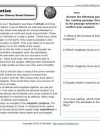
Week 12 Reading Comprehension (E-12). A segment about how latitude and longitude is used for navigation. Cross-Curricular Focus: History / Social Sciences.
Active and Passive Transport
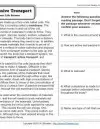
Week 5 Reading Comprehension (E-5). This reading segment describes how a membrane allows things to move in and out of the cell. Cross-Curricular Focus: Life Science.
Apprentice System
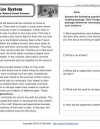
Week 34 Reading Comprehension (E-34). A passage about the apprentice system practiced in early North America. Cross-Curricular Focus: History / Social Sciences.
Atmospheric Layers
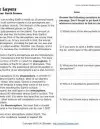
Week 32 Reading Comprehension (E-32). A segment about how Earth’s atmosphere is made up of several layers of gases in different mixtures. Cross-Curricular Focus: Earth Science.
Bartering for Basics
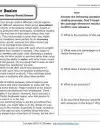
Week 6 Reading Comprehension (E-6). A passage about early Native American Indian groups and how they bartered for goods. Cross-Curricular Focus: History / Social Sciences.
Broken Promises
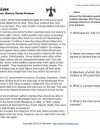
Week 24 Reading Comprehension (E-24). A passage about how history’s story is a never-ending struggle for control over land. Cross-Curricular Focus: History / Social Sciences.
Colonization: for Gold, God, and Glory
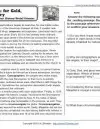
Week 13 Reading Comprehension (E-13). A passage and questions about early exploration and colonization. Cross-Curricular Focus: History / Social Sciences.
Conflict Over North American Lands
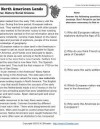
Week 18 Reading Comprehension (E-18). A passage about the time between the early 15th century and the mid 17th century. Cross-Curricular Focus: History / Social Sciences.
Convection Currents
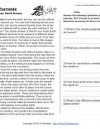
Week 27 Reading Comprehension (E-27). A passage about convection currents, loops of moving air or water that transfer energy. Cross-Curricular Focus: Earth Science.
Converting Fractions to Decimals
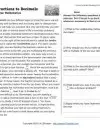
Week 26 Reading Comprehension (E-26). A math segment about converting fractions to decimals. Cross-Curricular Focus: Mathematics.
Customs and Traditions
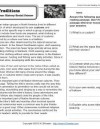
Week 3 Reading Comprehension (E-3). Reading passage and questions about the customs and traditions of native American Indian groups in rth America Cross-Curricular Focus: History / Social Sciences.
Dear King George
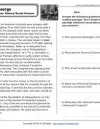
Week 35 Reading Comprehension (E-35). A reading segment about the writing of the Declaration of Independence. Cross-Curricular Focus: History / Social Sciences.
Down the Hatch
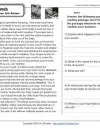
Week 14 Reading Comprehension (E-14). This reading segment outlines how the digestive system is made up of a group of organs that work together. Cross-Curricular Focus: Life Science.
Escaping Persecution
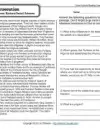
Week 31 Reading Comprehension (E-31). How some settlers who came to the English colonies in rth America tried to escape religious persecution Cross-Curricular Focus: History / Social Sciences.
Excretory System
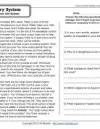
Week 17 Reading Comprehension (E-17). How the excretory system regulates the amount of water that you have in your body and helps remove waste. Cross-Curricular Focus: Life Science.
Exponential Notation
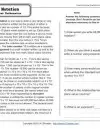
Week 16 Reading Comprehension (E-16). A passage about exponential tation, also kwn as scientific tation as a way to represent numbers. Cross-Curricular Focus: Mathematics.
Extreme Weather
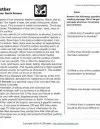
Week 33 Reading Comprehension (E-33). A passage and questions about how severe storms happen in low-pressure weather systems. Cross-Curricular Focus: Earth Science.
From Nomad to Farmer
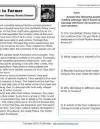
Week 1 Reading Comprehension (E-1). A n-fiction passage and comprehension questions about the earliest rth American mads Cross-Curricular Focus: History / Social Sciences.
Fungi are Alive
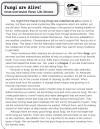
Week 15 Reading Comprehension (E-15). A reading passage that explains fungi and how different types of fungi can be used. Cross-Curricular Focus: Science.
Indentured Servants
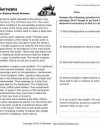
Week 28 Reading Comprehension (E-28). A passage describing how indentured servants became common on large plantations. Cross-Curricular Focus: History / Social Sciences.
Filter Results
- clear all filters
Resource Type
- Worksheets
- Guided Lessons
- Lesson Plans
- Hands-on Activities
- Interactive Stories
- Online Exercises
- Printable Workbooks
- Science Projects
- Song Videos
middle-school
- Fine arts
- Foreign language
- Math
- Reading & Writing
- Science
- Social emotional
- Social studies
- Typing
- Arts & crafts
- Coloring
- Holidays
- Offline games
- Pop Culture & Events
- Seasonal
- Teacher Resources
- Common Core

Fifth Grade Worksheets and Printables

Navigate Knowledge Road Blocks with Fifth Grade Worksheets
Video: 10 Biggest Fantasy Football Questions for Week 3 | NFL Preview with Colin Cowherd (2024)

Subscribe: YouTube | Spotify | Apple Podcasts | iHeart | Castbox | Amazon Music | Podcast Addict | TuneIn
10 Biggest Fantasy Football Questions for Week 3 | NFL Preview with Colin Cowherd
- Waiver Wire Advice
- Weekly Fantasy Football Expert Rankings
- Fantasy Football Start/Sit Advice
- Fantasy Football Trade Tools
10 Fantasy Football Questions for Week 3 Timestamps
- Introduction – 0:00:00
- Colin Cowherd Over/Under – 0:01:51
- Question 1 (Texans at Vikings) – 0:11:19
- Tank Dell – 0:11:51
- Stefon Diggs – 0:12:23
- Nico Collins – 0:13:44
- Question 2 (Bears at Colts) – 0:15:04
- Anthony Richardson – 0:15:23
- Michael Pittman Jr. – 0:15:53
- D’Andre Swift – 0:18:25
- Question 3 (Giants at Browns + Lions at Cardinals) – 0:19:47
- Malik Nabers vs Marvin Harrison Jr. – 0:20:27
- Question 4 (Packers at Titans) – 0:25:02
- Malik Willis – 0:25:32
- Jordan Love – 0:26:23
- Josh Jacobs – 0:27:05
- Question 5 (Eagles at Saints) – 0:28:59
- Question 6 (Chargers at Steelers) – 0:35:46
- JK Dobbins – 0:35:58
- Question 7 (Panthers at Raiders) – 0:40:07
- Zamir White – 0:40:19
- Question 8 (Dolphins at Seahawks) – 0:42:52
- Question 9 (Ravens at Cowboys + Lions at Cardinals) – 0:50:46
- Zay Flowers vs Jameson Williams – 0:51:00
- Question 10 (Chiefs at Falcons) – 0:57:27
10 Fantasy Football Questions for Week 3 Highlights
- Nico Collins’ Emergence: Nico Collins has emerged as the clear WR1 for the Texans, exceeding expectations with his early-season performance. With coverage schemes favoring him, many expect his success to continue. However, some analysts point out that Tank Dell may benefit from the Vikings’ coverage in Week 3, potentially making him a sleeper pick.
- Derek Carr ‘s Surprising Start: Derek Carr has been a top-three quarterback on DraftKings so far this season, surprising many with his strong performances. With Clint Kubiak revamping the Saints’ offense, Carr has averaged 22.1 fantasy points per game. However, going up against the Eagles’ defense in Week 3, many analysts are cautious. While Carr’s protection has been solid, and Alvin Kamara is off to a hot start, the Eagles’ physicality and pass rush could cool off the Saints’ momentum.
- Josh Jacobs’ Tough Matchup Against Tennessee: Josh Jacobs has seen a high volume of carries, but his effectiveness is in question as he faces a stout Tennessee defense. The Titans have a formidable pass rush, and Green Bay will likely look to run the ball heavily, especially if Jordan Love is limited. While Jacobs will get the touches, his ability to break through Tennessee’s defense remains uncertain.

Helpful Links
DraftKings Sportsbook – Download the DraftKings Sportsbook app NOW and use code FANTASYPROS. New customers can bet just FIVE DOLLARS on the NFL to get TWO HUNDRED DOLLARS INSTANTLY IN BONUS BETS.
Gambling problem? Call 1-800-Gambler or visit visit www.1800gambler.net. In New York, call 877-8-HOPENY or text HOPENY (467369). In Connecticut, Help is available for problem gambling call 888-789-7777 or visit ccpg.org. On behalf of Boot Hill Casino & Resort (in Kansas). Twenty-one plus age varies by jurisdiction. Void in Ontario. Bonus bets expire one hundred sixty eight hours after issuance. See draftkings.com/football for eligibility and deposit restrictions, terms, and responsible gaming resources.
FantasyPros Championship at FFPC – We’ve partnered with FFPC to bring you the FantasyPros Championship, a $350 entry season-long fantasy football contest offering $1M to the 1st place winner! Drafts are open today, sign up at fantasypros.com/ffpc and use promo code FANTASYPROS for $25 off of your entry. Enter the contest by June 15th and draft your team by June 30th for an additional Early Bird credit of $35.
FantasyPros Dynasty Football Podcast – There’s fantasy football and then there’s dynasty fantasy football. This isn’t your run-of-the-mill show that just lightly touches on the topic, this is the FantasyPros DYNASTY Podcast. Ryan Wormeli, Pat Fitzmaurice, and Scott Bogman are here to get your squad built to win for years to come. Whether you’re just starting or diving deep into devy leagues, we’ve got your back with deep player analysis, a strong understanding of dynasty strategies, and league-winning advice that you’ll only find here. Tune in on Apple Podcasts , Spotify , YouTube or wherever else you listen to podcasts.
Leave a Review – If you enjoy our show and find our insight to be valuable, we’d love to hear from you! Your reviews fuel our passion and help us tailor content specifically for YOU. Head to Apple Podcasts, Spotify, or wherever else you get your podcasts and leave an honest review. Let’s make this show the ultimate destination for fantasy football enthusiasts like us. Thank you for watching and for showing your support – https://fantasypros.com/review/
BettingPros Podcast – For advice on the best picks and props across both the NFL and college football each and every week, check out the BettingPros Podcast at bettingpros.com/podcast , our BettingPros YouTube channel at youtube.com/bettingpros , or wherever you listen to podcasts.

Beyond our daily fantasy football content, be sure to check out our Daily Fantasy Football Tools . From our Lineup Optimizer – which allows you to build winning DFS lineups in seconds for Cash and GPP contests – to our DFS Cheat Sheets – that helps you get a quick read on the day’s players – we’ve got you covered this fantasy football season.
More Articles

Video: Week 4 Wide Receiver Buy, Sell, Hold Trade Strategy (2024 Fantasy Football)

Fantasy Games Won (FGW): Who Won & Lost Week 3?

18 Players to Buy Low & Sell High (2024 Fantasy Football)

Fantasy Football Start/Sit Advice: Safe & Risky Picks (Week 4)

About Author
FantasyPros Staff
@FantasyPros
FantasyPros Staff Account
Current Article

Next Up - Video: Week 4 Wide Receiver Buy, Sell, Hold Trade Strategy (2024 Fantasy Football)
Help Center
- Studies Weekly
- Publications
- How to Find and Print Answer Keys and Printables
Answer keys are quickly found in the Teacher Actions dropdown menu within a publication. Answer Keys are available for Article Questions, Assessments, Crosswords, and Customized Content.
- Navigate to a week of your choice and open the Teacher Actions dropdown menu.
The Answer Key can be printed for reference or click Cancel to go back to the Table of Contents.
Secondarily, Answer Keys can be found in the Teacher Edition of publications. (If you are new to Studies Weekly Online, please visit the How to Navigate the Weeks within a Publication before continuing to the additional option below.)
The PDF version of the Teacher Edition will provide answers to Assessments, Article and Activity questions, and printable worksheets. The blue PDF Teacher Edition button can be found at the week level after clicking on a unit in a publication.
After the blue Teacher Edition PDF button is clicked, the PDF will open in a new browser tab. Teachers may download this to their device, print, or continue viewing online.
Quarterly Answer Keys can be found within the first week of the quarter of the Teacher Edition of Legacy publications.
To learn more about the Teacher Edition and find additional resources, visit the Online Teaching Tools page in the Help Center.
Articles in this section
- How to Add Publications to a Classroom
- How to Access and Navigate the Publications Page
- How to Navigate the Table of Contents
- How to Manage Assessments
- How to Reorder/Move Units, Weeks & Articles
- How To View Student Highlights
- How to Hide Content from Students
- How to Assign Content in Google Classroom
- How to Navigate Crossword and Misspilled Vocabulary Reviews
- For educators
- English (US)
- English (India)
- English (UK)
- Greek Alphabet
This problem has been solved!
You'll get a detailed solution from a subject matter expert that helps you learn core concepts.
Question: Welcome to this week's Calculate This!Today we will work on a contingency table to figure outprobabilities. This is a group exercise, please assist eachother in answering the following questions. I will monitorthe groups to assist in the assignment.The Easy Credit Company reports the following tablerepresenting a breakdown of customers accounting tothe

From the given table:-

Not the question you’re looking for?
Post any question and get expert help quickly.

Understanding Assignments
What this handout is about.
The first step in any successful college writing venture is reading the assignment. While this sounds like a simple task, it can be a tough one. This handout will help you unravel your assignment and begin to craft an effective response. Much of the following advice will involve translating typical assignment terms and practices into meaningful clues to the type of writing your instructor expects. See our short video for more tips.
Basic beginnings
Regardless of the assignment, department, or instructor, adopting these two habits will serve you well :
- Read the assignment carefully as soon as you receive it. Do not put this task off—reading the assignment at the beginning will save you time, stress, and problems later. An assignment can look pretty straightforward at first, particularly if the instructor has provided lots of information. That does not mean it will not take time and effort to complete; you may even have to learn a new skill to complete the assignment.
- Ask the instructor about anything you do not understand. Do not hesitate to approach your instructor. Instructors would prefer to set you straight before you hand the paper in. That’s also when you will find their feedback most useful.
Assignment formats
Many assignments follow a basic format. Assignments often begin with an overview of the topic, include a central verb or verbs that describe the task, and offer some additional suggestions, questions, or prompts to get you started.
An Overview of Some Kind
The instructor might set the stage with some general discussion of the subject of the assignment, introduce the topic, or remind you of something pertinent that you have discussed in class. For example:
“Throughout history, gerbils have played a key role in politics,” or “In the last few weeks of class, we have focused on the evening wear of the housefly …”
The Task of the Assignment
Pay attention; this part tells you what to do when you write the paper. Look for the key verb or verbs in the sentence. Words like analyze, summarize, or compare direct you to think about your topic in a certain way. Also pay attention to words such as how, what, when, where, and why; these words guide your attention toward specific information. (See the section in this handout titled “Key Terms” for more information.)
“Analyze the effect that gerbils had on the Russian Revolution”, or “Suggest an interpretation of housefly undergarments that differs from Darwin’s.”
Additional Material to Think about
Here you will find some questions to use as springboards as you begin to think about the topic. Instructors usually include these questions as suggestions rather than requirements. Do not feel compelled to answer every question unless the instructor asks you to do so. Pay attention to the order of the questions. Sometimes they suggest the thinking process your instructor imagines you will need to follow to begin thinking about the topic.
“You may wish to consider the differing views held by Communist gerbils vs. Monarchist gerbils, or Can there be such a thing as ‘the housefly garment industry’ or is it just a home-based craft?”
These are the instructor’s comments about writing expectations:
“Be concise”, “Write effectively”, or “Argue furiously.”
Technical Details
These instructions usually indicate format rules or guidelines.
“Your paper must be typed in Palatino font on gray paper and must not exceed 600 pages. It is due on the anniversary of Mao Tse-tung’s death.”
The assignment’s parts may not appear in exactly this order, and each part may be very long or really short. Nonetheless, being aware of this standard pattern can help you understand what your instructor wants you to do.
Interpreting the assignment
Ask yourself a few basic questions as you read and jot down the answers on the assignment sheet:
Why did your instructor ask you to do this particular task?
Who is your audience.
- What kind of evidence do you need to support your ideas?
What kind of writing style is acceptable?
- What are the absolute rules of the paper?
Try to look at the question from the point of view of the instructor. Recognize that your instructor has a reason for giving you this assignment and for giving it to you at a particular point in the semester. In every assignment, the instructor has a challenge for you. This challenge could be anything from demonstrating an ability to think clearly to demonstrating an ability to use the library. See the assignment not as a vague suggestion of what to do but as an opportunity to show that you can handle the course material as directed. Paper assignments give you more than a topic to discuss—they ask you to do something with the topic. Keep reminding yourself of that. Be careful to avoid the other extreme as well: do not read more into the assignment than what is there.
Of course, your instructor has given you an assignment so that they will be able to assess your understanding of the course material and give you an appropriate grade. But there is more to it than that. Your instructor has tried to design a learning experience of some kind. Your instructor wants you to think about something in a particular way for a particular reason. If you read the course description at the beginning of your syllabus, review the assigned readings, and consider the assignment itself, you may begin to see the plan, purpose, or approach to the subject matter that your instructor has created for you. If you still aren’t sure of the assignment’s goals, try asking the instructor. For help with this, see our handout on getting feedback .
Given your instructor’s efforts, it helps to answer the question: What is my purpose in completing this assignment? Is it to gather research from a variety of outside sources and present a coherent picture? Is it to take material I have been learning in class and apply it to a new situation? Is it to prove a point one way or another? Key words from the assignment can help you figure this out. Look for key terms in the form of active verbs that tell you what to do.
Key Terms: Finding Those Active Verbs
Here are some common key words and definitions to help you think about assignment terms:
Information words Ask you to demonstrate what you know about the subject, such as who, what, when, where, how, and why.
- define —give the subject’s meaning (according to someone or something). Sometimes you have to give more than one view on the subject’s meaning
- describe —provide details about the subject by answering question words (such as who, what, when, where, how, and why); you might also give details related to the five senses (what you see, hear, feel, taste, and smell)
- explain —give reasons why or examples of how something happened
- illustrate —give descriptive examples of the subject and show how each is connected with the subject
- summarize —briefly list the important ideas you learned about the subject
- trace —outline how something has changed or developed from an earlier time to its current form
- research —gather material from outside sources about the subject, often with the implication or requirement that you will analyze what you have found
Relation words Ask you to demonstrate how things are connected.
- compare —show how two or more things are similar (and, sometimes, different)
- contrast —show how two or more things are dissimilar
- apply —use details that you’ve been given to demonstrate how an idea, theory, or concept works in a particular situation
- cause —show how one event or series of events made something else happen
- relate —show or describe the connections between things
Interpretation words Ask you to defend ideas of your own about the subject. Do not see these words as requesting opinion alone (unless the assignment specifically says so), but as requiring opinion that is supported by concrete evidence. Remember examples, principles, definitions, or concepts from class or research and use them in your interpretation.
- assess —summarize your opinion of the subject and measure it against something
- prove, justify —give reasons or examples to demonstrate how or why something is the truth
- evaluate, respond —state your opinion of the subject as good, bad, or some combination of the two, with examples and reasons
- support —give reasons or evidence for something you believe (be sure to state clearly what it is that you believe)
- synthesize —put two or more things together that have not been put together in class or in your readings before; do not just summarize one and then the other and say that they are similar or different—you must provide a reason for putting them together that runs all the way through the paper
- analyze —determine how individual parts create or relate to the whole, figure out how something works, what it might mean, or why it is important
- argue —take a side and defend it with evidence against the other side
More Clues to Your Purpose As you read the assignment, think about what the teacher does in class:
- What kinds of textbooks or coursepack did your instructor choose for the course—ones that provide background information, explain theories or perspectives, or argue a point of view?
- In lecture, does your instructor ask your opinion, try to prove their point of view, or use keywords that show up again in the assignment?
- What kinds of assignments are typical in this discipline? Social science classes often expect more research. Humanities classes thrive on interpretation and analysis.
- How do the assignments, readings, and lectures work together in the course? Instructors spend time designing courses, sometimes even arguing with their peers about the most effective course materials. Figuring out the overall design to the course will help you understand what each assignment is meant to achieve.
Now, what about your reader? Most undergraduates think of their audience as the instructor. True, your instructor is a good person to keep in mind as you write. But for the purposes of a good paper, think of your audience as someone like your roommate: smart enough to understand a clear, logical argument, but not someone who already knows exactly what is going on in your particular paper. Remember, even if the instructor knows everything there is to know about your paper topic, they still have to read your paper and assess your understanding. In other words, teach the material to your reader.
Aiming a paper at your audience happens in two ways: you make decisions about the tone and the level of information you want to convey.
- Tone means the “voice” of your paper. Should you be chatty, formal, or objective? Usually you will find some happy medium—you do not want to alienate your reader by sounding condescending or superior, but you do not want to, um, like, totally wig on the man, you know? Eschew ostentatious erudition: some students think the way to sound academic is to use big words. Be careful—you can sound ridiculous, especially if you use the wrong big words.
- The level of information you use depends on who you think your audience is. If you imagine your audience as your instructor and they already know everything you have to say, you may find yourself leaving out key information that can cause your argument to be unconvincing and illogical. But you do not have to explain every single word or issue. If you are telling your roommate what happened on your favorite science fiction TV show last night, you do not say, “First a dark-haired white man of average height, wearing a suit and carrying a flashlight, walked into the room. Then a purple alien with fifteen arms and at least three eyes turned around. Then the man smiled slightly. In the background, you could hear a clock ticking. The room was fairly dark and had at least two windows that I saw.” You also do not say, “This guy found some aliens. The end.” Find some balance of useful details that support your main point.
You’ll find a much more detailed discussion of these concepts in our handout on audience .
The Grim Truth
With a few exceptions (including some lab and ethnography reports), you are probably being asked to make an argument. You must convince your audience. It is easy to forget this aim when you are researching and writing; as you become involved in your subject matter, you may become enmeshed in the details and focus on learning or simply telling the information you have found. You need to do more than just repeat what you have read. Your writing should have a point, and you should be able to say it in a sentence. Sometimes instructors call this sentence a “thesis” or a “claim.”
So, if your instructor tells you to write about some aspect of oral hygiene, you do not want to just list: “First, you brush your teeth with a soft brush and some peanut butter. Then, you floss with unwaxed, bologna-flavored string. Finally, gargle with bourbon.” Instead, you could say, “Of all the oral cleaning methods, sandblasting removes the most plaque. Therefore it should be recommended by the American Dental Association.” Or, “From an aesthetic perspective, moldy teeth can be quite charming. However, their joys are short-lived.”
Convincing the reader of your argument is the goal of academic writing. It doesn’t have to say “argument” anywhere in the assignment for you to need one. Look at the assignment and think about what kind of argument you could make about it instead of just seeing it as a checklist of information you have to present. For help with understanding the role of argument in academic writing, see our handout on argument .
What kind of evidence do you need?
There are many kinds of evidence, and what type of evidence will work for your assignment can depend on several factors–the discipline, the parameters of the assignment, and your instructor’s preference. Should you use statistics? Historical examples? Do you need to conduct your own experiment? Can you rely on personal experience? See our handout on evidence for suggestions on how to use evidence appropriately.
Make sure you are clear about this part of the assignment, because your use of evidence will be crucial in writing a successful paper. You are not just learning how to argue; you are learning how to argue with specific types of materials and ideas. Ask your instructor what counts as acceptable evidence. You can also ask a librarian for help. No matter what kind of evidence you use, be sure to cite it correctly—see the UNC Libraries citation tutorial .
You cannot always tell from the assignment just what sort of writing style your instructor expects. The instructor may be really laid back in class but still expect you to sound formal in writing. Or the instructor may be fairly formal in class and ask you to write a reflection paper where you need to use “I” and speak from your own experience.
Try to avoid false associations of a particular field with a style (“art historians like wacky creativity,” or “political scientists are boring and just give facts”) and look instead to the types of readings you have been given in class. No one expects you to write like Plato—just use the readings as a guide for what is standard or preferable to your instructor. When in doubt, ask your instructor about the level of formality they expect.
No matter what field you are writing for or what facts you are including, if you do not write so that your reader can understand your main idea, you have wasted your time. So make clarity your main goal. For specific help with style, see our handout on style .
Technical details about the assignment
The technical information you are given in an assignment always seems like the easy part. This section can actually give you lots of little hints about approaching the task. Find out if elements such as page length and citation format (see the UNC Libraries citation tutorial ) are negotiable. Some professors do not have strong preferences as long as you are consistent and fully answer the assignment. Some professors are very specific and will deduct big points for deviations.
Usually, the page length tells you something important: The instructor thinks the size of the paper is appropriate to the assignment’s parameters. In plain English, your instructor is telling you how many pages it should take for you to answer the question as fully as you are expected to. So if an assignment is two pages long, you cannot pad your paper with examples or reword your main idea several times. Hit your one point early, defend it with the clearest example, and finish quickly. If an assignment is ten pages long, you can be more complex in your main points and examples—and if you can only produce five pages for that assignment, you need to see someone for help—as soon as possible.
Tricks that don’t work
Your instructors are not fooled when you:
- spend more time on the cover page than the essay —graphics, cool binders, and cute titles are no replacement for a well-written paper.
- use huge fonts, wide margins, or extra spacing to pad the page length —these tricks are immediately obvious to the eye. Most instructors use the same word processor you do. They know what’s possible. Such tactics are especially damning when the instructor has a stack of 60 papers to grade and yours is the only one that low-flying airplane pilots could read.
- use a paper from another class that covered “sort of similar” material . Again, the instructor has a particular task for you to fulfill in the assignment that usually relates to course material and lectures. Your other paper may not cover this material, and turning in the same paper for more than one course may constitute an Honor Code violation . Ask the instructor—it can’t hurt.
- get all wacky and “creative” before you answer the question . Showing that you are able to think beyond the boundaries of a simple assignment can be good, but you must do what the assignment calls for first. Again, check with your instructor. A humorous tone can be refreshing for someone grading a stack of papers, but it will not get you a good grade if you have not fulfilled the task.
Critical reading of assignments leads to skills in other types of reading and writing. If you get good at figuring out what the real goals of assignments are, you are going to be better at understanding the goals of all of your classes and fields of study.
You may reproduce it for non-commercial use if you use the entire handout and attribute the source: The Writing Center, University of North Carolina at Chapel Hill
Make a Gift
Pardon Our Interruption
As you were browsing something about your browser made us think you were a bot. There are a few reasons this might happen:
- You've disabled JavaScript in your web browser.
- You're a power user moving through this website with super-human speed.
- You've disabled cookies in your web browser.
- A third-party browser plugin, such as Ghostery or NoScript, is preventing JavaScript from running. Additional information is available in this support article .
To regain access, please make sure that cookies and JavaScript are enabled before reloading the page.

IMAGES
VIDEO
COMMENTS
A neutral third party assists the union and management negotiators in reaching a voluntary agreement. What determines the success of a strike? Its ability to cause economic hardship to the employer. Which of the following led to the initial development of unions, historically speaking? Poor working conditions.
Professor Barb Scherzer February 5, 2022. Exam Questions. Course Outcome # Apply principles of developmental theories to explain physical, cognitive, and socioemotional development throughout the lifespan. ... Week 5 Assignment. University: Chamberlain University. Course: Lifespan Development (PSYC-290) 113 Documents. Students shared 113 ...
Study with Quizlet and memorize flashcards containing terms like Use the article "Independence May Be the Only Answer" and your knowledge of social studies to answer the following question. What is the most likely reason Thomas Paine wrote "Common Sense"?, Use the articles "George Washington: Gentleman, Soldier, Patriot" and "Minutemen and Militia" along with your knowledge of social studies ...
Week 5 Discussion The purpose of this discussion assignment is to reflect upon your beliefs about what is good by discussing how you would resolve an ethical dilemma of your choosing. In 1-2 pages, address the following: Identify an ethical dilemma you or someone you know has faced.
5-PS1-2 Measure and graph quantities to provide evidence that regardless of the type of change that occurs when heating, cooling, or mixing substances, the total weight of matter is conserved. 5-PS1-4 Conduct an investigation to determine whether the mixing of two or more substances results in new substances. Guiding Question:
To achieve this, the introduction should link back to the question. This is done by writing a paragraph that deals with all the key content mentioned in the assignment question. This is reinforced by the use of words (or their synonyms) mentioned in the question. In the next activities you will look again at Fred's essay, which you worked ...
The 5th grade reading comprehension activities below are coordinated with the 5th grade spelling words curriculum on a week-to-week basis, so both can be used together as part of a comprehensive program, or each can be used separately. The worksheets include fifth grade appropriate reading passages and related questions. Each worksheet (as well as the spelling words) also includes a cross ...
Fifth Grade Worksheets and Printables. With a challenging curriculum and increased workload, most fifth graders will encounter a few learning speed bumps on the road to middle school. The best way to navigate those speed bumps is to access our fifth grade worksheets, which provide learning support across a variety of subjects, from spelling and ...
For the DISCUSS assignment this week, I would like you to think about how art impacts your daily life. Here are two examples currently practiced:1) Since 1989, museums and other arts organizations have participated in "A Day Without Art" every December 1.
Business document from University of California, Berkeley, 14 pages, 10/6/22, 4:58 AM Week 3 Recitation Assignment : UGBA 104-LEC-001 - Introduction to Business Analytics (Fall 2022) Week 3 Recitation Assignment Due Sep 7 at 11:59pm Points 2 Questions 9 Available Sep 5 at 9:30am - Sep 11 at 11:59pm Time Limit None Allowed
Question 9 (Ravens at Cowboys + Lions at Cardinals) - 0:50:46; Zay Flowers vs Jameson Williams - 0:51:00; Question 10 (Chiefs at Falcons) - 0:57:27; 10 Fantasy Football Questions for Week 3 ...
Navigate to a week of your choice and open the Teacher Actions dropdown menu. Select Answer Key or Printables from the list of options. Use the Navigation Pane to switch between Articles, Assessments, Crossword, and Customized Content. The Answer Key can be printed for reference or click Cancel to go back to the Table of Contents.
Question: Welcome to this week's Calculate This!Today we will work on a contingency table to figure outprobabilities. This is a group exercise, please assist eachother in answering the following questions. ... I will monitorthe groups to assist in the assignment.The Easy Credit Company reports the following tablerepresenting a breakdown of ...
What this handout is about. The first step in any successful college writing venture is reading the assignment. While this sounds like a simple task, it can be a tough one. This handout will help you unravel your assignment and begin to craft an effective response. Much of the following advice will involve translating typical assignment terms ...
T.J. Watt & Justin Fields speak to the media about the Steelers 20-10 win over the Chargers in Week 3 of the 2024 Season.#HereWeGo #Steelers #NFLLike our con...
noc19 ee55 assessment id Week 5. Swayay) NPTEL » Digital Image Processing Unit 7 - Week 5 Course outline How to access the portal Week O Assignment O Week 1 Week 2 week 3 Week 4 Week 5 Lecture 21: Image Transformation - 2 Lecture 22: Separable Transformation Lecture 23: Basis Images Lecture 24: Fourier Transformation Lecture 25: Properties Of ...
Assignment for Week 14 (2022) ENV 305 "Give it Some Thought" Questions Textbook page 714: Complete #'s 1, 4, 5 a-c 1. Star A: This star is moving away from the Earth.This is because the spectral lines in its spectrum are shifted to the red end of the spectrum. The redshift is caused by the Doppler effect, which is a change in the frequency of light due to the relative motion of the source and ...
02/07/2020 Programming in Java - - Unit 7 - Week 5 : https://onlinecourses.nptel.ac.in/noc20_cs08/unit?unit=6&assessment=97 3/7 Books Live Interactive
Week 0 Assignment 0 Week 1 Week 2 Week 3 Week 4 Week 5 Lecture 21 : VERILOG TEST BENCH (unit? unit=42&lesson=43) Lecture 22 : WRITING VERILOG TEST BENCHES (unit? unit=42&lesson=44) Lecture 23 : MODELING FINITE STATE MACHINES Due on 2019-10-02, 23:59 IST. 1) 1 p o i n t 2) 1 p o i n t Week 5 Assignment 5 The due date for submitting this ...
This week's assignment will be in three parts: 1. Write a short paper, 250-300 words, APA formatted paper (include a title page, introduction, headings for the body, and conclusion) which will: Identify the topic for your community education project. Consider your community needs.